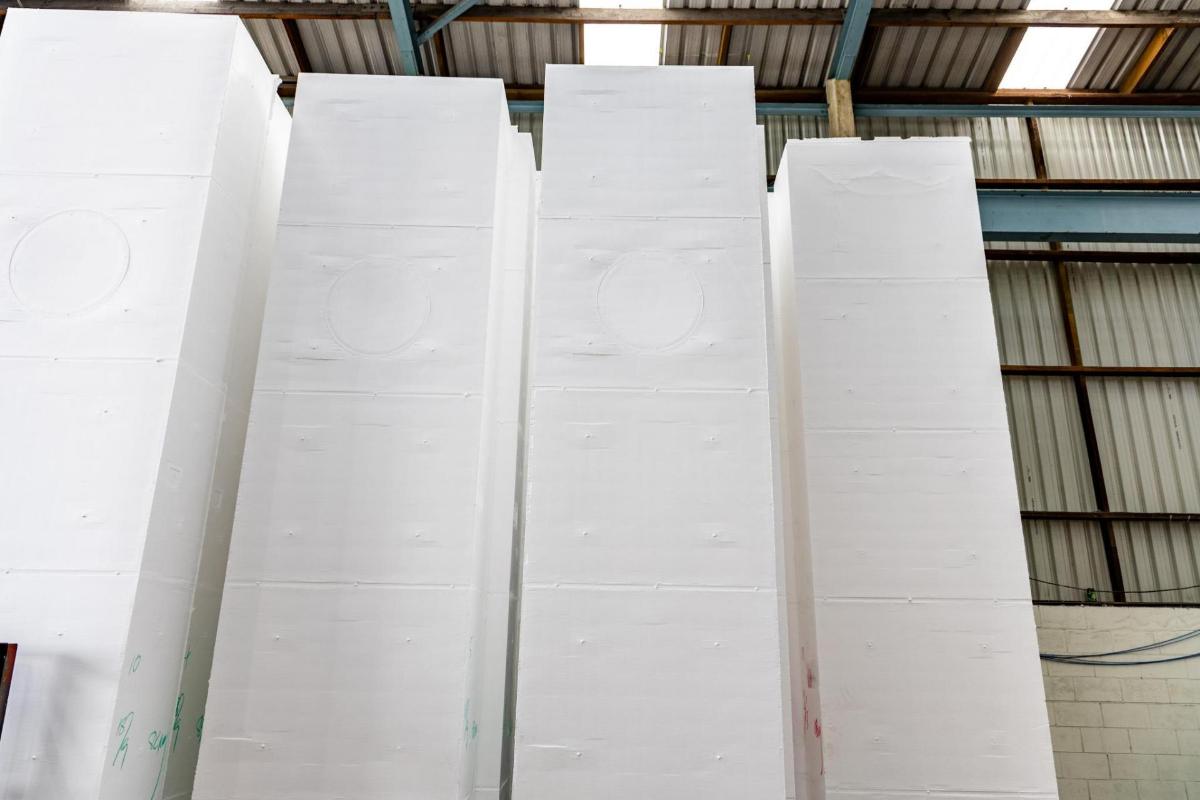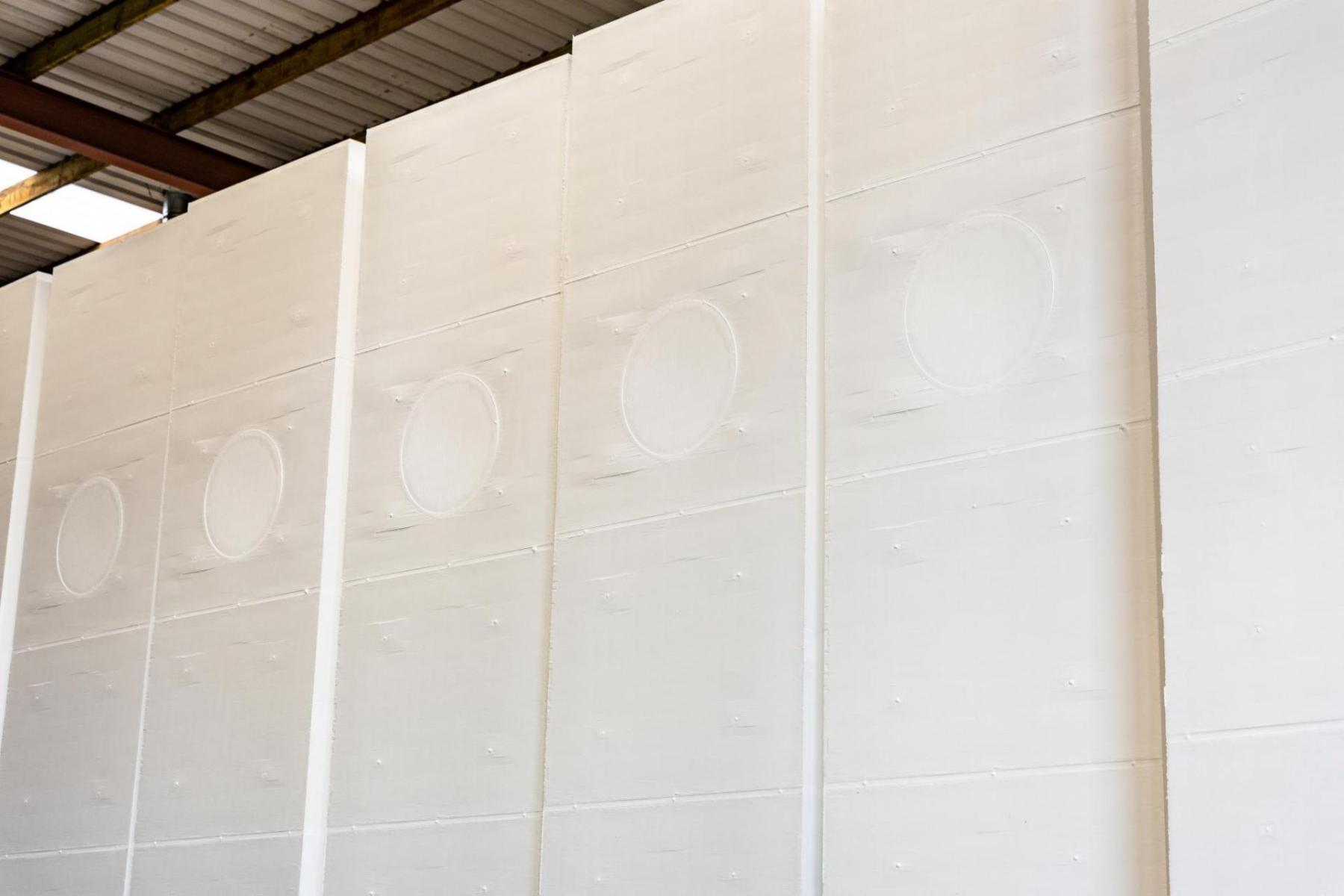
Lightweight In-Ground Fill
Geofoam
GEOFOAM is a solid block of (EPS) Expanded Polystyrene and is available in a range of densities from 12kg up to 30kg/m3.
Our blocks are supplied as 5025 x 1225 x 525mm (3.25m3/block), however half blocks can be cut to suit specified layouts. Geofoam is Lightweight and Rigid remaining inert over long periods of time. Geofoam is approximately 100 times lighter than soil. Geofoam is proven as a cost effective fill that will significantly reduce project lead times and provide superior earth stabilisation. Geofoam is manufactured to AS1366 Part3 Standard.
Applications
- Behind Retaining Walls
- Highway Stabilisation
- Bulk filling of large areas
- Slope Stabilisation
- Ramps for bridges and embankments

GEOFOAM has been used successfully in different environments worldwide. Geofoam’s lightweight characteristics provide ease of handling, bulk fill, performance insulation, low water permeability as well as strength and deformation properties that complement every application.
Contact us for our best pricing, based on the volume and the required density as specified by the civil engineering consultant.

Technical Resources
1. What is Geofoam?
Geofoam is a lightweight, rigid, and versatile material made from expanded polystyrene (EPS) foam. It is commonly used in construction and engineering projects as a fill material, insulation, or lightweight structural support. Geofoam is known for its low density, high compressive strength, and ease of installation.
2. What are the benefits of using Geofoam?
Geofoam offers several advantages:
• Lightweight: Its low density makes it easy to transport and handle, reducing labor and transportation costs.
• High Compressive Strength: Geofoam can support heavy loads despite its lightweight nature, making it ideal for use in construction.
• Insulation: It provides excellent thermal insulation, helping to regulate temperature in various applications.
• Moisture Resistance: Geofoam does not absorb water, making it suitable for wet or humid environments.
• Durability: Geofoam is resistant to decay, rot, and deterioration, ensuring a long service life.
• Environmentally Friendly: Geofoam can be made from recycled materials and is often recyclable.
3. What are the primary uses of Geofoam?
Geofoam is used in various applications, including:
• Lightweight fill material: For roads, embankments, and other civil engineering projects where reducing weight is important.
• Insulation: For foundations, floors, and walls to reduce heat loss or gain.
• Slope stabilization: To provide support for unstable slopes or embankments.
• Void filling: To fill voids in construction projects, such as under roads or near retaining walls.
• Bridge approach fills: To reduce the load on bridge structures during construction.
• Landfills: For lightweight fill that doesn’t add significant weight or pressure to the ground.
4. How is Geofoam installed?
Geofoam is typically installed by stacking the blocks or sheets in place, similar to building with large, lightweight bricks. They can be cut to size on-site using standard cutting tools. The installation process is straightforward and can be completed quickly due to the material’s lightweight nature.
5. How strong is Geofoam?
Geofoam has high compressive strength, making it suitable for supporting structural loads. The compressive strength of Geofoam can vary depending on the density of the material, with higher-density Geofoam able to support more weight. It can withstand loads from buildings, roadways, and other structures without significant deformation.
6. Is Geofoam environmentally friendly?
Geofoam can be considered environmentally friendly for several reasons:
• It is recyclable, and many Geofoam products are made from recycled polystyrene.
• Geofoam produces fewer carbon emissions during transport compared to other heavier fill materials.
• It does not decompose, rot, or attract pests, which can help maintain the integrity of the surrounding environment.
However, like any synthetic material, its environmental impact depends on how it is produced and disposed of. Efforts to recycle and properly dispose of Geofoam can help mitigate its environmental footprint.
7. Is Geofoam resistant to moisture?
Yes, Geofoam is moisture-resistant. It does not absorb water, which makes it ideal for use in areas where moisture could cause problems, such as foundations, retaining walls, or road embankments exposed to rain or groundwater.
8. How long does Geofoam last?
Geofoam has a long lifespan when used in construction and civil engineering projects. It is resistant to decay, rotting, and biological degradation. As long as it is properly installed and not exposed to harsh environmental conditions like extreme UV radiation or chemicals, Geofoam can last for decades.
9. Can Geofoam be used for road construction?
Yes, Geofoam is commonly used in road construction, particularly for lightweight fill applications. It helps reduce the weight placed on underlying structures, which can prevent settlement and reduce the potential for soil movement. Geofoam is also used to stabilize embankments, prevent erosion, and provide thermal insulation beneath roadways.
10. Is Geofoam fire-resistant?
Geofoam itself is not inherently fire-resistant, but it can be treated with fire retardants to improve its fire resistance. Geofoam’s fire resistance depends on the specific material used and any treatments applied during manufacturing. It’s important to verify fire ratings when using Geofoam in applications where fire safety is a concern.
11. Can Geofoam be used for insulation?
Yes, Geofoam is an excellent material for thermal insulation. It is widely used in foundation systems, floors, roofs, and walls to reduce heat loss or gain. Geofoam provides a high R-value (thermal resistance) per unit thickness, making it highly effective in regulating temperature.
12. What types of Geofoam are available?
Geofoam is available in various densities and sizes to suit different applications. Common densities range from 15 kg/m³ (for non-load-bearing applications) to 40 kg/m³ or more (for load-bearing applications). The specific density required depends on the project’s load-bearing needs and insulation requirements.
13. Is Geofoam easy to cut?
Yes, Geofoam is relatively easy to cut with basic tools such as a hot wire cutter, saw, or knife. Custom shapes and sizes can be cut to meet the specific requirements of a project, and Geofoam can be trimmed or shaped on-site as needed.
14. What are the challenges of using Geofoam?
While Geofoam offers many benefits, there are some challenges to consider:
• Cost: Geofoam can be more expensive than traditional fill materials like soil or gravel.
• UV exposure: If Geofoam is exposed to sunlight for long periods, it can degrade, so it may need to be covered or protected with a UV-resistant layer.
• Transportation: Although Geofoam is lightweight, large quantities of Geofoam still require careful planning for transportation, especially in remote areas.
15. Is Geofoam safe to handle?
Geofoam is safe to handle, as it is non-toxic and does not pose health risks under normal use. However, like any construction material, it is recommended to wear protective gear such as gloves and safety glasses when cutting or handling Geofoam to avoid irritation or injury.
